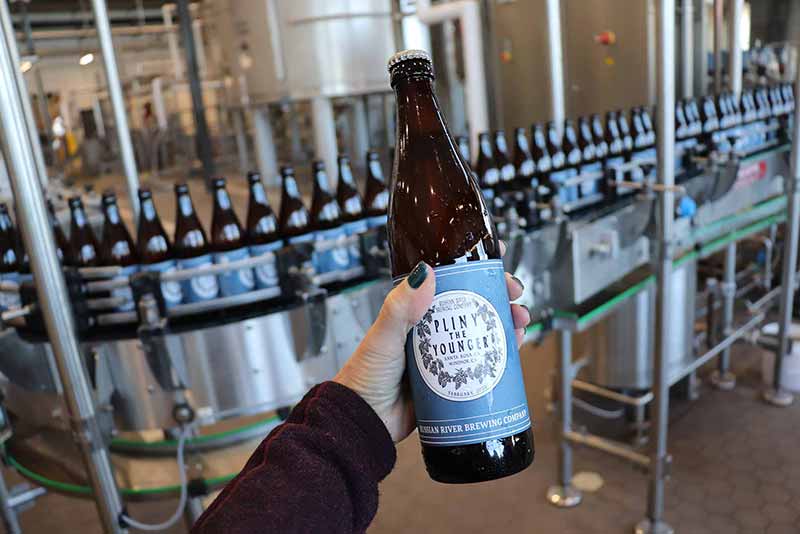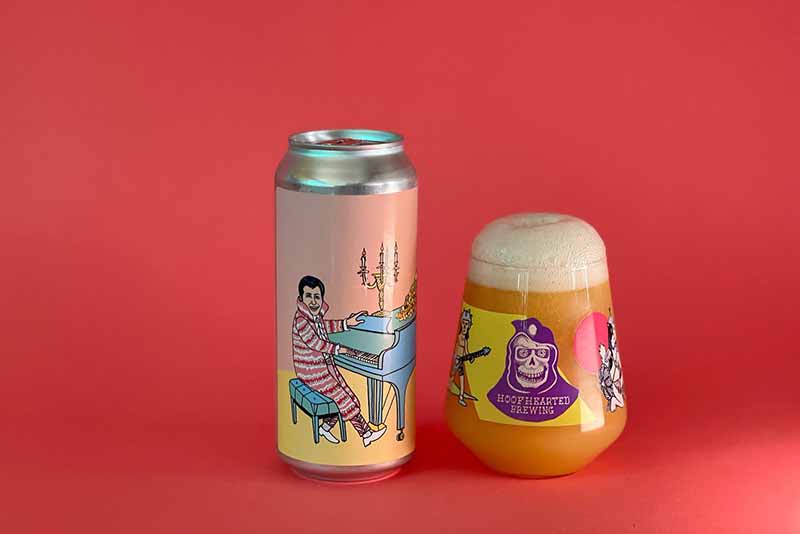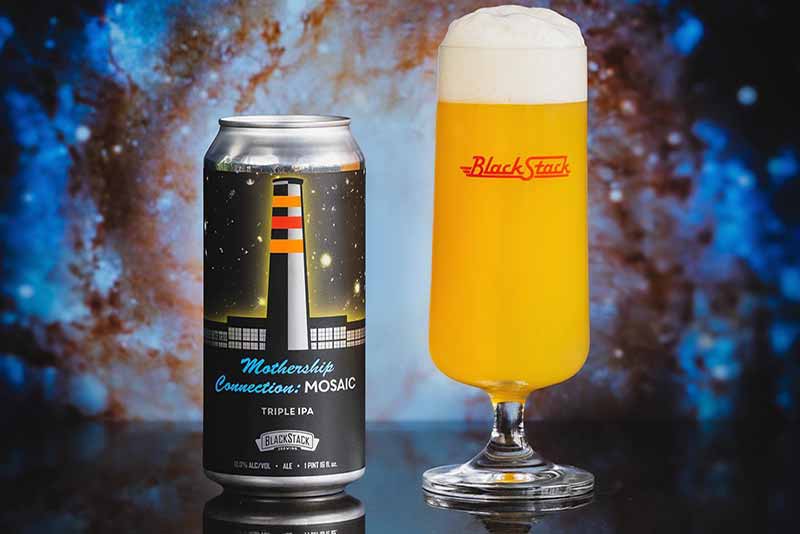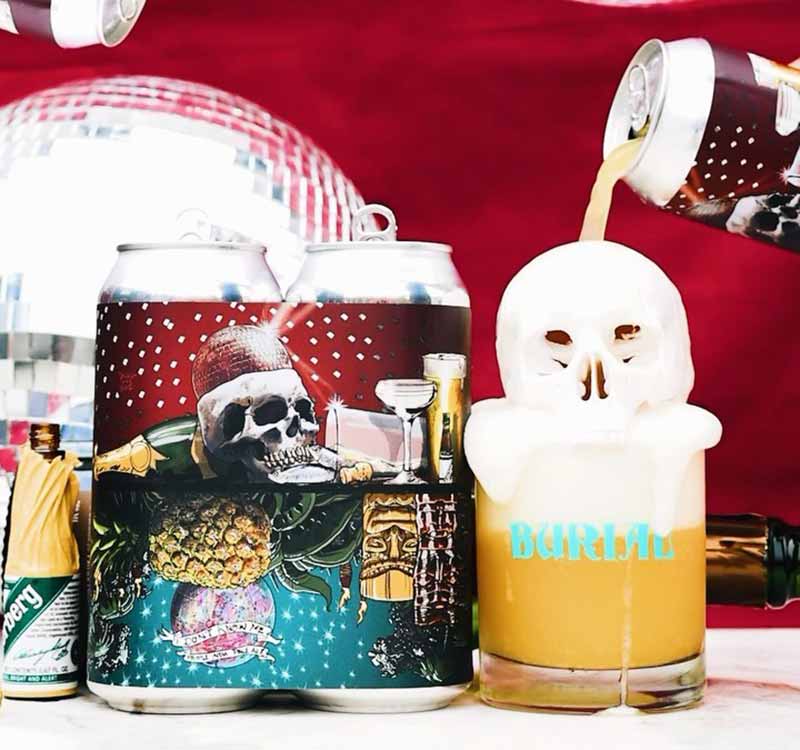
We know that IPA is king in the craft beer industry. Last year’s Untappd check-in data revealed that IPAs were the top-four checked-in styles in the app. In 2021, IPAs were the top three checked-in ones, with five in the top ten. Suffice it to say not much is changing in the interest of the craft beer consumer.
We’ve covered many an IPA in this space, including how to nail a solid session IPA, your flexibility when brewing an American IPA, and how the double IPA might just be the sweet spot of the hop-forward beer.
Triple IPAs are a different ball game. As you creep into those higher ABV ranges, things can get finicky if you aren’t careful enough. Brewers at BlackStack Brewing and Burial Beer broke it down for us on how to walk that tightrope of malts and hops to concoct a killer triple IPA.
(Above image courtesy of @blackstackbrewing)
What We’ll Cover in This Piece:
Affordable, Industry-Leading Brewery Software
How Do You Define a Triple IPA?

One of the most iconic examples of a triple IPA, Russian River’s Pliny the Younger | Photography courtesy of Russian River Brewing Company
In some cases, the triple IPA is not a thing. For instance, neither the Brewers Association nor the Great American Beer Festival have triple IPA as a style. The BA’s closest category is an imperial IPA or double IPA, which they say spans up to 10.6% ABV. The GABF has two styles that fall into the realm of a perceived triple IPA: imperial IPA and experimental IPA, which both have high-end ABVs of 10.6 percent.
But plenty of brewers would disagree.
“Triple IPAs are heavy hitters,” Burial Brewing Head Brewer Alia Midoun says. “One of the most important aspects of making a good triple IPA here at Burial is keeping it from being overly boozy while having a medium-full body, smooth mouthfeel, and a pungent hop aroma and flavor.”
When it comes to triple IPAs, BlackStack Brewing Founder Murphy Johnson has specific notes he’s trying to reach.
“Bright, vibrant, oil-saturated celebrations of fruit-forward hops that are full-bodied,” he says, adding, “without being cloying or boozy.”
What Considerations to Make When Brewing a Triple IPA

Hoof Hearted $120 Nachos triple IPA | Photography courtesy of @hoofheartedbrewing
Johnson says it’s all about hitting the perfect finishing gravity when brewing a solid triple IPA. For BlackStack, that’s in the four to five Plato range.
“Fermented too far down, you can take away a lot of the body that the hops need for a balance to not come off as aggressive or angular,” Johnson says. “Not fermented far enough, they can present as a sweet, cloying mess.”
Midoun focuses on overall drinkability as well.
“Making sure the beer is smooth, still pleasant to drink,” she says of Burial’s top consideration when brewing a triple IPA. “And finding a way to balance out the weight of the beer to prevent the high ABV from impacting the flavor profile negatively.”
Johnson adds that tight practices in the cellaring process can help you avoid oxidization and recommends unitanking to aid in the process.
What Does A Triple IPA Grist Look Like?

Photography courtesy of @blackstackbrewing
Midoun and Johnson stress the importance of grains in executing a solid triple IPA.
“Keep the Lovibonds extremely low across the board in the grain bill,” Johnson says. “In our experience, more highly kilned malt can lead to fresh hoppy beer tasting less bright or older.”
BlackStack shoots for between sixty and seventy percent of a highly light base malt—think Pilsner malts. They throw in thirty to forty percent of higher protein or less modified malts like wheat, oats, spelt, or chit.
“We typically tend to keep the flaked portion fairly low, usually in the range of five percent to ten percent,” Johnson notes. “We’ll typically use a small portion of dextrose or brewer’s crystals and a hefty dose of rice hulls if we have any substantial amount of flakes.”
Burial doesn’t have a specific grist they go with every time, with Midoun saying they play around a bit with it while regularly implementing oats and pale malts no matter what. That said, they don’t take the grist lightly.
“The grain bill becomes just as important as the hop bill to make these beers smooth, soft, and enjoyable to drink,” she says.
They mash it around 151 or 152 degrees Fahrenheit resulting in a higher finishing gravity that lends a sweeter flavor profile.
“We keep IBUs low to avoid amplifying the beer more than it already is. This contributes to the overall juicy, fruity, and smooth, easy-drinking aspect,” Midoun says.
How Many Hops Should You Use in a Triple IPA?

BlackStack Brewing TFree HBC 586 triple IPA | Photography courtesy of @blackstackbrewing
BlackStack uses a minimum of one pound per barrel of T-90 hop pellets during the whirlpool and dry hop charges that start at about four and a half pounds per barrel.
“We’re trying to get as much oil into solution as possible,” Johnson says. “So both those can increase substantially depending on what we’re going for with the beer.”
With the beers heavily hopped, Johnson says that the total time to turn around the beer from brew to packaging is around a month to allow it to mature.
“The hop loads are so heavy for these beers that they tend to take quite a bit for greenness or hop bite to dissipate,” he says.
Midoun says their hops, like the grist, vary.
“Hot side completely depends on our choice of hops and their individual characteristics or alpha acids,” she says. “Cold side is also variable and dependent on the bouquet of hops we choose to showcase.”
Generally, Midoun says, Burial charges five to six pounds per barrel on the cold side.
Is There a Special Yeast Strain for a Triple IPA?
You really don’t want your yeast to struggle when fermenting out a high-alcohol beer. A healthy pitch is vital to strong fermentation. As to what yeast to use, Johnson plays around with a few.
“Typically London Ale 3 or a thiolized version of it,” Johnson says. “We also enjoy playing around with Kölsch yeast and more fruit-forward strands of Kveik.”
He adds, “Sometimes we co-pitch with Chico to help it finish fermentation strong.”
What Is a Typical Triple IPA ABV?

BlackStack Brewing Mothership Connection: MOSAIC triple IPA | Photography courtesy of @blackstackbrewing
Right around 10% ABV seems to be the sweet spot for triple IPAs. But not all high-ABV beers are created equal. The challenge is to make it palatable.
“Not only are they generally targeting a 10-10.5% ABV, but they’re going to pack a lot of punch when it comes to flavor,” Midoun says. “We want our TIPAs to be so silky smooth, so you’ll question whether the ABV is actually that high.”
Johnson agrees on the ABV but says there is room to play.
“Depends on what you’re going for, but for us, our happy place tends to be in the 10-10.5% ABV range,” he says.
Two Examples of a Great Triple IPA

Burial Beer I Don’t Know Me triple IPA | Photography courtesy of @burialbeer
Burial just dropped a new triple IPA that Midoun is really proud of, called I Don’t Know Me. The 10.5% ABV beer has 29 IBUs and is hopped with a combination of Simcoe, Strata, Mosaic, and Sabro.
“The intention behind it was to create a crushed pineapple tiki spiced cocktail-like beverage,” Midoun says. “And it did a good job of executing those targets while remaining a smooth, drinkable beverage.”
Johnson says the first thing that comes to mind as a great BlackStack triple IPA is Free HBC 586. The beer is 10% ABV and loaded with HBC 586 and HBC 586 Cryo hops.
“It’s a series we do with some of our favorite varietals on a clean but full-bodied malt bill,” Johnson says. “We spend so much time creating hop blends based on terpenes and oil percentages, so it can be extremely refreshing to taste an unfettered expression of what one hop is capable of.”



